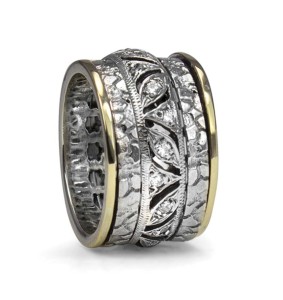Trying something different

Attitudes among designers may be changing. Look no further than Italian brand Garavelli, which is testing a new line of nine-karat gold in some markets. The collection is a far cry from the company’s staple of 18-karat gold pieces, but the catch is, the lower content prices the jewellery at what the metal cost five years ago. Consider also Tiffany & Co.’s Rubedo, a proprietary alloy comprising 55 per cent copper. With a gold content of 31 per cent or 7.5 karats, it is far too low to legally carry a gold stamp, which according to the company, has not worked against it.
An interesting perspective comes from the other side of the world. Steve Sesselmann, owner of Bee Jewellery in Australia, sees resurgence in nine-karat gold in his country. “I believe we are now seeing a swing back to this [metal],” he says. “Consumers are largely driven by what jewellery is being marketed, and I believe the time is ripe for this gold.”
According to the Competition Bureau, and contrary to what many throughout the industry believe, nine-karat gold products are legal in Canada, (even as finished jewellery or casting grains, etc.) as long as they are stamped as such.*
Sesselmann also supplies to the Canadian market. Even though he only has a few active customers here, he says nine-karat gold jewellery is an option they rely on to satisfy the price-conscience consumer’s appetite for the yellow metal. Could this lower alloy shine in today’s Canadian market? Let’s consider the evidence.
Popularity contest
When it comes to the popularity of the various karats around the world, it’s interesting to note that in North America, 14- and 18-karat gold are predominately used in fine jewellery, 18-karat is preferred in Europe and Asia, and in India, it’s 22- and 24-karat. However, in the Australian market, consumers are used to the term ‘nine-karat’ and see no problem with it being used in the fine jewellery category. Of course, the higher karats are readily available there, but Sesselmann lets us in on a consumer secret. “Many in Australia see nine-karat gold as a stronger alloy because it is largely mixed with other metals,” says Sesselmann.
So could the popularity of karat simply come down to where you live and what most consumers are buying? After all, the masses can keep a trend going until it becomes de rigueur. Consider for a moment that since nine-karat gold has simply gone unused for so long in most markets, maybe it has un-vogued itself? Traimer—whose line of nine-karat jewellery is manufactured in Israel—has a different opinion on the matter. “I think in the past, nine-karat gold may have had a stigma that it was [inferior], and that’s a hard reputation to break,” she says.
However, the answer for many jewellers could be as simple as removing that stigma by reintroducing clients to nine-karat gold and getting them excited for a lower-content alloy that still provides them with that gold look. “The price is the reason why we work with nine-karat gold,” says Traimer.





